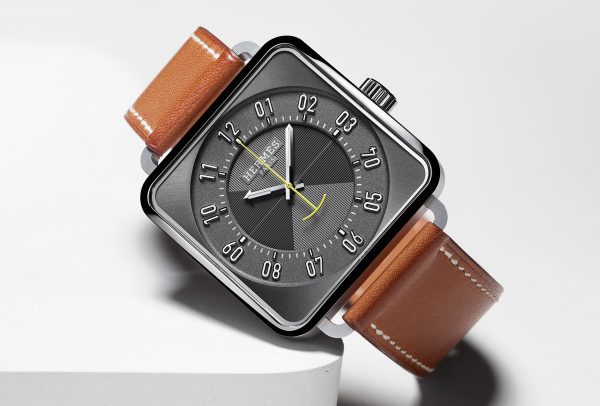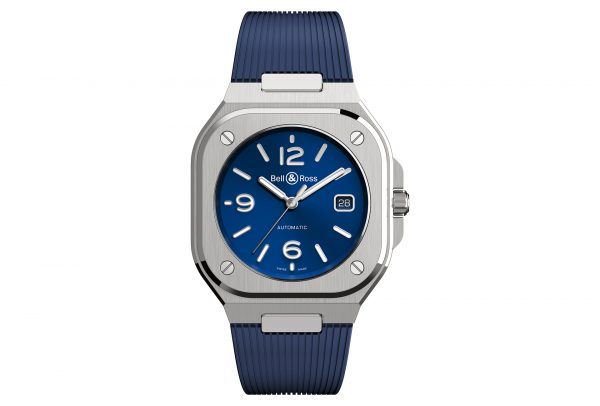One good thing about maths lessons is that they seem to stick in artistic directors’ minds. Who would have thought geometry teachers worked for the good of the arts? Hermès, for one, has succeeded in transforming a quadrilateral into a style icon, namely the Hermès silk square (90 x 90cm). One sells every thirty minutes. After 80 years of fame (and fortune), there had to be a watch waiting to happen. Enter the Carré H (“carré” is French for “square”), the work of designer Marc Berthier. Pitched as “the architect’s watch”, it started life as a limited edition in 2010. The 2019 version has gained a few extra millimetres to create a larger dial opening. Other changes are the way light dances across the polished and beadblasted steel case, hour markers of varying thickness, and the zero that creates a double-digit equilibrium around the dial. As ever, the devil is in the detail of the softly rounded corners, answering the question, when is a square not a square? A cylindrical sapphire crystal sits above the multi-layer dial, a characteristic more often found on a round watch. Used here to create a visual break in an otherwise austere square?

Time square
Rest assured it’s not that simple. Around 80% of watches sold today are round. And while the public is by no means averse to a non-round watch – the so-called form watches, which include squares – brands that step outside the circle must do so in the most subtle of ways. Some, such as Hermès, play down this rigid four-sidedness. Others choose instead to accentuate it with manly tones. This is the path Cartier took with the Santos. Characteristic of the revolution that was early twentieth-century design, the Santos’s straight lines broke the round mould of the predominant pocket watch. Following in its ancestor’s wake, this year’s iteration shouts out to its urban shape This is a landmark watch mirroring a Parisian landmark: the Eiffel Tower and its four corners. Eight exposed screws confirm the sentiment of a miniature monument on the wrist. It is an ode to industrial beauty that nonetheless gives its wearer the possibility to return to a softer aesthetic, courtesy of the patented QuickSwitch system to effortlessly swap straps.
Variable geometry
Sometimes the road to success is paved with squares. Bell & Ross is a case in point. Thanks to multiple iterations of the BR 01, the Franco-Swiss brand has made a name with its signature design of a circle inside a square, the idea being to turn a plane’s cockpit clock into a wristwatch. This has produced a series of best-sellers, the latest being the BR 05. It belongs to the family of watches whose case and bracelet form a seamless whole. This time, however, the 40mm case has a less angular appearance, with polished edges that accentuate the layered volumes. It’s a form of compromise that brings a contemporary slant to the brand’s “time instruments” and opens them up to the cool guy in the street. Hautlence is another brand channelling the power of the right angle. While the Vortex isn’t a perfect quadrilateral, here too the shape has become a synonym for the brand. The paradigm of the perfect circle is no more. Made from grade 5 titanium, the case of the HL Vagabonde 03 boasts Hautlence’s favourite TV-screen shape.

Four sides to a story
A square can become an accidental icon. It’s what happened to TAG Heuer’s Monaco, revealed to the world on March 3, 1969 in Geneva and New York. Its water-resistant square case, blue dial and crown at 9 o’clock were like nothing the industry had ever seen before. But the story really began with an innovative movement. Calibre 11 was part of the race to produce the first self-winding chronograph and Heuer’s then CEO, Jack Heuer, wanted to launch this groundbreaking mechanism in a statement design. One of the firm’s suppliers, Piquerez, offered him a square case secured by four clips that exerted pressure against its sides. And the Monaco was born! The watch earned its claim to fame when Steve McQueen wore it in Le Mans, shot in 1969 and released in 1971. The Monaco celebrated its half-century in suitable style this year with five limited editions, the last of which has just been released. The Monaco Calibre 12 Final Edition is a lesson in sobriety. The 39mm satin-brushed steel case incorporates polished pushers in harmony with the vertically brushed grey dial. Adding a festive touch of colour are the 12 o’clock index, the central seconds hand, and the tips of the hour and minute hands. Keeping time is Calibre 12, an updated version of the original Calibre 11. A square comes full circle!





















